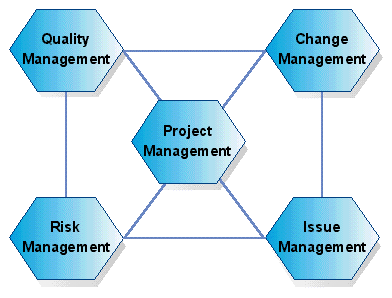Project Management
Overview
Strong project management discipline is necessary to ensure that project objectives are achieved on time and on budget. Without a strong project management framework, even the best methodology can fail on key issues.
A project management framework is best based on the principle that project management is a discipline unto itself and is therefore separate and distinct from actual delivery.
Typically project management includes five key interrelated project management components:
- Project Management.
- Quality Management.
- Issue Management.
- Change Management.
- Risk Management.

All five activities are considered the responsibility of the Project Manager, working in conjunction with the project team, and the client Project Sponsor. The following sections describe the approaches that will be used to perform these management activities.
Key Elements
The Project Management Institute (PMI) standard approach is a deliberate and disciplined approach to technology projects based on defined sets of principles, models, disciplines, concepts, guidelines, and proven practices.
Key elements of this discipline are the use of standard processes and reports throughout the project lifecycle. These include:
- Project Status Report -- This document template contains information regarding the status of the project and is used as a communications tool by the Program Manager to inform the client of any outstanding project issues, development status as well as any other items of interest that need to be addressed to ensure the successful outcome of the project.
- Change Request -- This document contains information regarding the nature of a change, the sponsor(s) of a change and an estimate of the time required to analyze and develop a change. Analysis performed is subsequently added to the functional requirements and amendments to any development plans, testing plans and other related adjustments are also made provided the change has been accepted and approved by the business stakeholders.
- Issue Tracking & Reporting – This element promotes pro-active identification and resolution of issues. That is, rather than reacting to issues once they arise, our Project Manager will constantly scan all project-related activities for potential issues. The sooner an issue is dealt with, the less likely the chance of damage to the project. Communication and coordination of resolution of the issue is key.
- Risk Tracking & Reporting - This document contains information regarding all the risks that are associated with the project. Information tracked includes risk statement, the date the risk was identified, the person responsible for managing the identified risk and the mitigation approach. each risk is tracked and escalated further when the date the risk needs to be solved by approaches. This report is closely managed and tracked during the Project Status meetings and Project Steering Committee meetings.
Quality Assurance Management
The Quality Assurance Program is used to identify, assess and mitigate project risks and ensure the successful achievement of the project objectives, particularly those related to, or dependent on, the quality of the deliverables.
The objectives of Quality Assurance Program it is necessary to:
-
Manage the integration of governance,
process, and technology policies. -
Determine the appropriate application of
methodology and tools for the project.
- Finalize deliverable standards and integration processes.
- Manage the issue resolution process.
- Manage quality assurance review preparation and execution.
Our projects include a rigorous quality assurance process. In engagements of this nature, a proven quality assurance program helps confirm all team members are performing to the required standards and that deliverables meet the project’s objectives and your needs.
The quality management program should encompass the following objectives:
-
The assurance that the project’s final delivery is
consistent with the objectives originally defined. -
The creation of deliverable templates and procedures
(example: acceptance testing standards, training scenarios).
-
The clarification and documentation of client expectations
about the services to be delivered. -
The determination of build and integration points as well as
required functionality at those points. -
Conducting on-site Quality Assurance Reviews
including interviews with project and client staff.
Issue Management
Issue management is a project management function. An issue is anything that has the potential to impact the success of a project. Most issues impact one or more of scope, budget, schedule or quality, but can impact other “softer” areas such as expectations and morale. Issue management covers the procedures defined to address and resolve issues.
Issue management involves identifying, managing, escalating, resolving and reporting issues that arise during the life of a project. An Issue log will be used to track and record issues with each issue being given a number, identification date, resolution date, category and owner.
Proper project management promotes pro-active identification and resolution of issues. That is, rather than just reacting to issues once they arise, a Project Manager must also constantly scan all project-related activities for potential issues. The sooner an issue is dealt with, the less likely the chance of damage to the project. Communication and coordination of resolution of the issue is the key. To ensure that this occurs, a review of the issues log and the resolution of the issue is a mandatory task at the scheduled status meetings.

